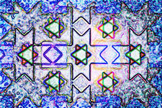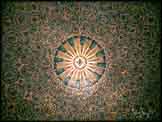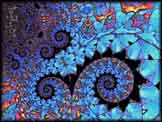 |
|

The man who tasted shapes : a bizarre medical mystery, Cytowic, Richard E., 1993, Putnam Books Synaesthesia : classic and contemporary readings, edited by Simon Baron-Cohen and John E. Harrison, 1997, Blackwell Publishing The Primary Colors Alexander Theroux, 1994, Henry Holt & Co. The Third Ear Joachim-Ernst Berendt, 1985, Henry Holt & Co. Synesthesia: A Union of the Senses, R. Cytowic, 1989, Springer-Verlag, NY Digital Harmony: On the Complementarity of Music and Visual Art, John Whitney, Byte, 1980. Bright Colors Falsely Seen: Synaesthesia & the Search for Transcendental Knowledge, by Kevin Dann, 1998

Lecture by Eric McLuhan on Synaesthesia at San Francisco State University's Multimedia Program, 1996 Dr Hugo Heyrman's "Museums of the Mind" Centre for Cognitive and Computational Neuroscience, at Stirling University Another SFSU page with links and a much more complete bibliography.
 |
Synaesthesia is the transposition of senses, a cross modal sensory way of perceiving the world in which we live, a virtual union of the senses. For example, you might see a certain colors or shapes when a certain song is played, or be reminded of a particular melody after staring a painting for a few minutes. Some people recieve these "mixed" perceptions on a constant basis. This phenomenon has been acknowledged by science for roughly 300 years, yet academic research into the subject remains scarce.
These people are called synaesthetes. They associate sounds with colors (or often smells with tastes and less often other combinations of the senses). It is thought that only a small percentage of the population have synaesthetic abilities. While this is probably true when measuring the population that experience this state of consciousness, the number of people with the potential to experience perception cross-modally is almost surely vast. I would suggest that synaesthesia is an ability which is potential in all people. Researchers have suggested the number of those with this ability at around 6% of the population. I would have guessed differently, but these researchers and "experts" suggest otherwise. The Centre for Cognitive and Computational Neuroscience, at Stirling University has a page with statistical rates of incidence, if you want to see a scientific study of the matter. To me, synaesthesia is something that is more likely to be apparent to an artist than a scientist, and studying the topic in a laboratory is akin to listening to music underwater or in a vacuum. For a real fact finding mission, go to an artists' collective or to a recording studio to hear people that talk in a way that begins to illustrate how pervasive synaesthesia is to people who spend time creating art. Ask a child to describe the taste of a hot summer day or a walk in the forest. Helen Keller does a good job describing what the essence of synaesthesia is. Some of the most highly regarded artists of our time have claimed some experiences with synaesthesia in their art, notably, writers and painters; William S. Burroughs, Timothy Leary, Tom Robbins, Thomas Pynchon, Carl G. Jung, Wassily Kandinsky, Claude Monet, Marc Chagall, Salvador Dali, numerous musicians including; Alexander Scriabin, Jerry Garcia, Jimi Hendrix, Bill Laswell, Roger Waters, John Lennon, Andy Summers, Roger McGuinn, Steve Hillage - filmmakers; Wim Wenders, Stanley Kubrick, and Terry Gilliam, just to name a few. Plus many more that I don't even claim to know about. For that matter I was just looking at some paintings by John Coltrane and Charlie Parker and boy, did they know what I'm talking about! Also check out the Blue Men Group and Cirque du Soleil for their performance oriented manifestations of synesthesia. I think it is strange that Yahoo.com lists synaesthesia under the heading Health: Diseases and Conditions: Synesthesia
For an excellent lecture on the subject, check out this Real Audio file at the San Francisco State University's Multimedia Programgiven by Eric McLuhan (the son of Marshall McLuhan). You will need the Real Audio plug-in for your browser. As mentioned above, the SFSU Multimedia Program page also has excellent lectures by Mark Pesce, Brenda Laurel and Howard Rheingold on totally different, but equally engaging subjects, although these might be getting dated now. And if you have any more links you would like to share please feel free to send them for inclusion. My apologies to those who have sent me some and for my negligence in posting them in a timely manner. Unfortunately these links have been lost, but would be grateful for others to send theirs for future updates. email me: bfly at todomundo.com |
|
BURNING MAN MAP TEXTURES SITE MAP HOME
last updated April 16, 2005 |